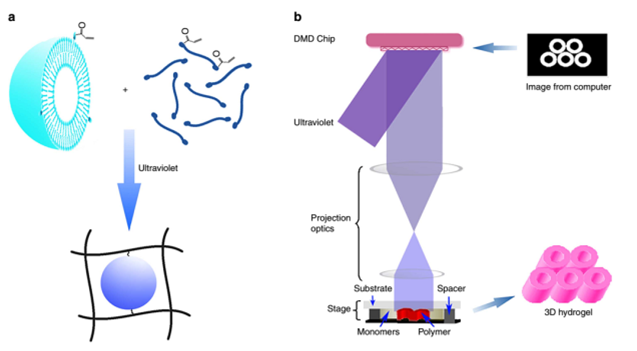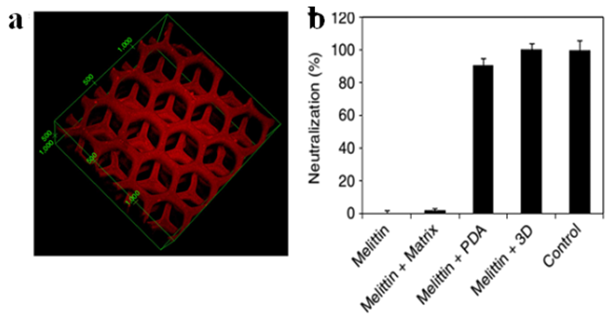Introduction: Rationally designed nanoparticles that can bind toxins show great promise for detoxification[1]. However, the conventional intravenous administration of nanoparticles for detoxification often leads to nanoparticle accumulation in the liver[2]. Cleaning blood by adsorption of toxins to retrievable nanoparticles provides an alternative strategy for detoxification. Here we fabricate nanoparticles into a liver-inspired detoxification device by 3D printing technology[3]. Our results show that the toxin solution completely loses its virulence after treatment using this biomimetic detoxification device.
Materials and Methods: First, surface modified polydiacetylene (PDA) nanoparticles that can neutralize pore-forming toxins were prepared. Then, PEGDA in H2O with 1% lithium phenyl-2,4,6-trimethylbenzoylphosphinate was mixed with PDA particles suspension, followed by 3D-printing into corresponding 3D structures via dynamic optical projection stereolithography (DOPsL) . Melittin was used as a model pore-forming toxins. The neutralization of the haemolytic activity of melittin by PDA functionalized device was assayed by a modified standard haemolytic assay procedure.
Results and Discussion: The PDA nanoparticle surface is made of a p-conjugated polymer with alternating double- and triple-bond groups in the main polymer chain. The cell membrane-mimicking surface functions to attract, capture and neutralize pore-forming toxins. The neutralization efficiency of PDA nanoparticles is 92%. The binding constant between melittin and PDA nanoparticles is 630 M- 1. The former interaction contributes much more than the latter.

Figure1 | Immobilization of PDA nanoparticles in 3D-structured PEGDA hydrogel. (a) Schematic presentation of installing PDA nanoparticles in the network of PEGDA hydrogel. (b) Schematic drawing of the DOPsL method to fabricate 3D-structured PEGDA hydrogel.
To chemically link PDA nanoparticles into the networks of PEGDA hydrogel, we synthesized a diacetylene derivative called PCDA-acrylamide. By mixing PCDA and PCDA- acrylamide , the resulting nanoparticles possess acrylamide group on its surface and can be chemically tethered to the PEGDA hydrogel through addition polymerization (Fig. 1a). The PDA nanoparticles have a mean particle size of 110 nm. Owing to the extremely slow degradation rate of PEGDA network, once chemically immobilized in PEGDA hydrogel, it is difficult for PDA nanoparticles to release into the solution. Taking advantages of the photocrosslinkable hydrogel, DOPsL technology was utilized to e fabricate 3D PEGDA hydrogels with precise microstructures, as shown in Fig. 1b.

Figure 2 | The bio-inspired 3D detoxifier. (a) The 3D structure of the detoxifier measured by laser confocal microscopy.(b) Neutralization efficiency of the 3D detoxifier.
We designed a liver-mimetic structure with modified liver lobule topology that allows the toxin to reach the centre of the matrix quickly[4]. The structure of this detoxifier was reconstructed and the results are presented in Fig. 2a. Our 3D biomimetic detoxifier achieved 100% neutralization of toxins while the equivalent amount of free PDA nanoparticles neutralizes 91% toxins, and the PEGDA hydrogel matrix alone has little capacity in neutralizing toxins (shown in Fig. 2b). Therefore, this biomimetic detoxifier can effectively neutralize toxins.
References:
[1] Maling Gou, et al. Nature Communications 2014 May 8;5:3774
[2] Che-Ming J. Hu, et al. Nature Nanotechnology 2013 May;8(5):336-40
[3] Maling Gou, et al. Sensor Acuat B 2010 July;150(1):406-411
[4] Xin Qu, et al. Nanomedicine 2014 Nov;9(16):2437-9